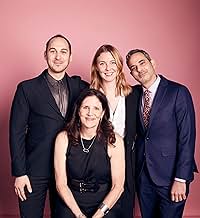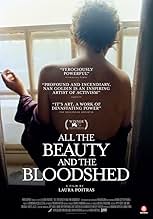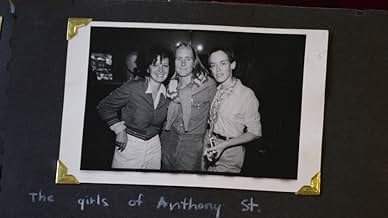CALIFICACIÓN DE IMDb
7.5/10
8.8 k
TU CALIFICACIÓN
La vida de la artista Nan Goldin y la caída de la familia Sackler, la dinastía farmacéutica responsable en gran medida del insondable número de víctimas mortales de la epidemia de opioides.La vida de la artista Nan Goldin y la caída de la familia Sackler, la dinastía farmacéutica responsable en gran medida del insondable número de víctimas mortales de la epidemia de opioides.La vida de la artista Nan Goldin y la caída de la familia Sackler, la dinastía farmacéutica responsable en gran medida del insondable número de víctimas mortales de la epidemia de opioides.
- Nominado a 1 premio Óscar
- 37 premios ganados y 57 nominaciones en total
Robert Drain
- Self - Judge
- (as Judge Robert Drain)
David Armstrong
- Self - Photographer and Friend of Nan
- (material de archivo)
Bruce Balboni
- Self - Actor
- (material de archivo)
Opiniones destacadas
This documentary about Nan Goldin and her battles throughout her life--personally and professionally--is many pronged with New York as the background. She was part of the art movement in the 1980's when AIDS started to invade that scene unabated since the administration of the time felt it was only a gay disease and would not be addressed. Her anger could have been surmised as the beginning there, but then we got a glimpse of her life growing up with the poor treatment her sister got by her parents. Things progressed from there. Her activism developed in the 1980's and continued into the age of Purdue Pharmacy's creation and rampant spread of oxycodone. The documentary may seem to be a bit of a hodgepodge of memories, but when you understand that her anger was developing almost from the moment she was born, you can understand how heartfelt her concern was for those who died around her. This was nominated as Best Feature Documentary for the Oscars It is an uncomfortable yet quite informative watch.
All the Beauty and the Bloodshed can join Fire of Love in the club of Oscar-nominated documentaries from 2022 that would have been more worthy winners than Navalny. It's admittedly a small club, but I feel like both of those movies have moments that demonstrate documentary filmmaking at its best.
In the case of All the Beauty and the Bloodshed, it's probably the final 15-20 minutes that shines the brightest. It can be a slow and somewhat uneven feeling documentary at some points, but it builds to some phenomenal and emotionally hard hitting final scenes. The rest of the documentary still tends to hit far more often than it misses, but I did get the sense it may have been a tiny bit too long, and while I respect the choice not to tie together its two primary narratives more explicitly, part of me was waiting for them to collide more directly at a point. Still, leaving some of that up to the viewer felt like a deliberate choice, and I can respect that.
It follows Nan Goldin, with the film both recounting her life story from the 1950s to the 1990s and detailing her activism against the Sackler family and their role in the opioid epidemic in the 2010s. The latter might be more interesting narratively, but the former has the more interesting presentation, seeing as Goldin's an accomplished artist/photographer, and the documentary frequently relies on her work to serve as visuals.
It's a heavy and often sad documentary, dealing with mental illness, addiction, corruption, censorship, the AIDS crisis, discrimination, and domestic violence. It might be upsetting to some viewers as a result, but I think it was best not to pull punches (so long as people know what they're in for before deciding to watch it). It's a largely powerful documentary that I think will stick with me. Not perfect, but it has some amazing sequences that were very striking and moving.
In the case of All the Beauty and the Bloodshed, it's probably the final 15-20 minutes that shines the brightest. It can be a slow and somewhat uneven feeling documentary at some points, but it builds to some phenomenal and emotionally hard hitting final scenes. The rest of the documentary still tends to hit far more often than it misses, but I did get the sense it may have been a tiny bit too long, and while I respect the choice not to tie together its two primary narratives more explicitly, part of me was waiting for them to collide more directly at a point. Still, leaving some of that up to the viewer felt like a deliberate choice, and I can respect that.
It follows Nan Goldin, with the film both recounting her life story from the 1950s to the 1990s and detailing her activism against the Sackler family and their role in the opioid epidemic in the 2010s. The latter might be more interesting narratively, but the former has the more interesting presentation, seeing as Goldin's an accomplished artist/photographer, and the documentary frequently relies on her work to serve as visuals.
It's a heavy and often sad documentary, dealing with mental illness, addiction, corruption, censorship, the AIDS crisis, discrimination, and domestic violence. It might be upsetting to some viewers as a result, but I think it was best not to pull punches (so long as people know what they're in for before deciding to watch it). It's a largely powerful documentary that I think will stick with me. Not perfect, but it has some amazing sequences that were very striking and moving.
As "All the Beauty and the Bloodshed" (2022 release; 118 min.) opens, it is "March 10, 2018", and a group of activists is staging a protest at the Met, more particularly the Sackler Wing. We then go to "1. Merciless Logic" as Nan Goldin starts talking about her early youth, and how her sister Barbara commits suicide when Nan was only 7. At this point we are less than 10 minutes into the film.
Couple of comments: this is the latest from well respected documentarian Laura Poitras ("Citizenfour"). Here she brings us a nuanced portrait and assessment of photographer Nan Goldin, best known for documenting the NY underground scene in the 70s and 80s. At the same time Poitras looks back at the mysterious suicide of Nan's sister Barbara in 1965. And last but not least, Poitras follows Goldin and other members of the activist group P. A. I. N. in their attempts to hold the Sackler family which owns Purdue Company, manufacturer of Valium and Oxycontin, responsible for the opioid crisis in this country (Goldin herself is a survivor of Oxycontin addiction). The beauty of this documentary consisting of 7 chapters is how these three subjects are woven together, with Goldin herself narrating much of it. I was absolutely fascinated by it all, and I am already going on record that this documentary is a shoo-in to get a Best Documentary Oscar nomination.
"All the Beauty and the Bloodshed" premiered at last Fall's Venice Film Festival to immediate critical acclaim, winning the festival's top prize along the way. It is currently rated 93% Certified Fresh on Rotten Tomatoes, and for very good reasons. I see a LOT of documentaries, and surely this is one of the very best, if not THE best, documentaries of 2022, and also one of the very best movies of 2002, period. The documentary opened this weekend at my local arthouse theater here in Cincinnati. The Tuesday evening screening where I saw this at was attended very nicely (I counted about 25-30 people). If you like a top-notch documentary, I'd readily suggest you check this out, and draw your own conclusion.
Couple of comments: this is the latest from well respected documentarian Laura Poitras ("Citizenfour"). Here she brings us a nuanced portrait and assessment of photographer Nan Goldin, best known for documenting the NY underground scene in the 70s and 80s. At the same time Poitras looks back at the mysterious suicide of Nan's sister Barbara in 1965. And last but not least, Poitras follows Goldin and other members of the activist group P. A. I. N. in their attempts to hold the Sackler family which owns Purdue Company, manufacturer of Valium and Oxycontin, responsible for the opioid crisis in this country (Goldin herself is a survivor of Oxycontin addiction). The beauty of this documentary consisting of 7 chapters is how these three subjects are woven together, with Goldin herself narrating much of it. I was absolutely fascinated by it all, and I am already going on record that this documentary is a shoo-in to get a Best Documentary Oscar nomination.
"All the Beauty and the Bloodshed" premiered at last Fall's Venice Film Festival to immediate critical acclaim, winning the festival's top prize along the way. It is currently rated 93% Certified Fresh on Rotten Tomatoes, and for very good reasons. I see a LOT of documentaries, and surely this is one of the very best, if not THE best, documentaries of 2022, and also one of the very best movies of 2002, period. The documentary opened this weekend at my local arthouse theater here in Cincinnati. The Tuesday evening screening where I saw this at was attended very nicely (I counted about 25-30 people). If you like a top-notch documentary, I'd readily suggest you check this out, and draw your own conclusion.
There's a family who had legalised addiction, who pushed their products to administer more affliction, once you're trapped it's hard to leave, there's a good chance that you'll grieve, if you know someone, they'll need more than benediction.
A wonderful piece of factual storytelling focused around Nan Goldin's pursuit of justice and recompense for those helplessly hooked on Oxycontin, a drug that was peddled without remorse by people who thought they were above the law. The film also explores in some detail the life of Nan, her career as an artist, the wild and colourful characters she got to know in NYC, and the often crazy things she found herself doing, as well as her life as a child and the sister she lost.
A wonderful piece of factual storytelling focused around Nan Goldin's pursuit of justice and recompense for those helplessly hooked on Oxycontin, a drug that was peddled without remorse by people who thought they were above the law. The film also explores in some detail the life of Nan, her career as an artist, the wild and colourful characters she got to know in NYC, and the often crazy things she found herself doing, as well as her life as a child and the sister she lost.
Laura Poitras' remarkable documentary ALL THE BEAUTY AND BLOODSHED which combines multiple story-lines into an incredible portrait of artist and activist, Nan Goldin. On the surface it appears as though the focus is on Goldin's attempt to bring to the public's attention the Sackler family's role as pharmaceutical kingpins during the opiod crisis. It begins with faux doctor's prescriptions and pill bottles raining down in a toney art gallery named after the Sacklers. It's a protest by Goldin's group P. A. I. N. (Prescription Addiction Intervention Now).
It's a powerful prologue, but, Poitras isn't simply interested in an advocacy documentary film here. It's a dense and intense exploration of Goldin, the person and the artist, and how her personal journey informed her activism.
Goldin is interviewed at length, and her personal writings and art are revealed in the most intimate manner. Goldin's photography evolved naturally. She was driven to document her own life and, from there, depicted an entire underground scene that had rarely been exposed to not only the art world - but, to the larger public. Goldin's fluid sexuality brought her to Provincetown and later the Burroughs of New York City, photographing everything and everyone she came in contact with. She never intentionally was putting together a portfolio - it just happened. The photographs are as private and personal as could be. Goldin never shied away from her innermost relationships, nor that of her circle of friends. That frankness is what eventually brought her to the recognition by the art world - even as it scandalized many of them. When AIDS hit her community, Goldin learned a lesson from the Act Up movement that carried on to her founding of P. A. I. N..
While all of that played out (eventually) in the public's eye, Poitras reveals Goldin's personal family life. Her strained relationship with her parents, and, most poignantly, of that with her sister who was institutionalized. Her sibling's story shows how a young woman's 'rebelliousness' can be struck down by the system and a forced dependency on drugs and a form of enslavement. It's something that Goldin carries with her to this day, including her own bout with opiods.
ALL THE BEAUTY AND THE BLOODSHED carries a lot on its plate. Poirtras' great achievement here is that no section of the movie feels out of place, nor does any part of it feel in any manner slighted. It's all of a piece melding Goldin's intensely personal quest, art and sense of social purpose.
Breathtaking.
It's a powerful prologue, but, Poitras isn't simply interested in an advocacy documentary film here. It's a dense and intense exploration of Goldin, the person and the artist, and how her personal journey informed her activism.
Goldin is interviewed at length, and her personal writings and art are revealed in the most intimate manner. Goldin's photography evolved naturally. She was driven to document her own life and, from there, depicted an entire underground scene that had rarely been exposed to not only the art world - but, to the larger public. Goldin's fluid sexuality brought her to Provincetown and later the Burroughs of New York City, photographing everything and everyone she came in contact with. She never intentionally was putting together a portfolio - it just happened. The photographs are as private and personal as could be. Goldin never shied away from her innermost relationships, nor that of her circle of friends. That frankness is what eventually brought her to the recognition by the art world - even as it scandalized many of them. When AIDS hit her community, Goldin learned a lesson from the Act Up movement that carried on to her founding of P. A. I. N..
While all of that played out (eventually) in the public's eye, Poitras reveals Goldin's personal family life. Her strained relationship with her parents, and, most poignantly, of that with her sister who was institutionalized. Her sibling's story shows how a young woman's 'rebelliousness' can be struck down by the system and a forced dependency on drugs and a form of enslavement. It's something that Goldin carries with her to this day, including her own bout with opiods.
ALL THE BEAUTY AND THE BLOODSHED carries a lot on its plate. Poirtras' great achievement here is that no section of the movie feels out of place, nor does any part of it feel in any manner slighted. It's all of a piece melding Goldin's intensely personal quest, art and sense of social purpose.
Breathtaking.
¿Sabías que…?
- TriviaThe title of the film is a reference to Nan Goldin's older sister, Barbara Holly Goldin. It's a direct quote from a mental health evaluation of Barbara during her time at an institution. She died by suicide in 1965, at the age of 18. This film and Nan Goldin's 1986 "The Ballad of Sexual Dependency" are dedicated to her.
- Citas
Nan Goldin: Photography is like a flash of euphoria.
- Bandas sonorasThe Cold Song
Performed by Klaus Nomi
Selecciones populares
Inicia sesión para calificar y agrega a la lista de videos para obtener recomendaciones personalizadas
- How long is All the Beauty and the Bloodshed?Con tecnología de Alexa
Detalles
- Fecha de lanzamiento
- País de origen
- Sitios oficiales
- Idioma
- También se conoce como
- All the Beauty and the Bloodshed
- Locaciones de filmación
- Nueva York, Nueva York, Estados Unidos(Metropolitan Art Museum protest)
- Productoras
- Ver más créditos de la compañía en IMDbPro
Taquilla
- Total en EE. UU. y Canadá
- USD 500,082
- Fin de semana de estreno en EE. UU. y Canadá
- USD 28,803
- 27 nov 2022
- Total a nivel mundial
- USD 1,483,975
- Tiempo de ejecución1 hora 53 minutos
- Color
- Mezcla de sonido
- Relación de aspecto
- 1.78 : 1
Contribuir a esta página
Sugiere una edición o agrega el contenido que falta

Principales brechas de datos
What is the streaming release date of La belleza y el dolor (2022) in Brazil?
Responda








































